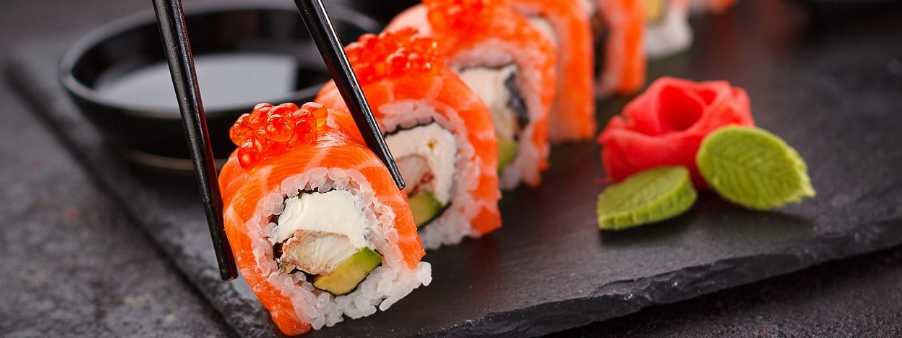

I’ll be honest — when most people think about making sushi at home, they either get super excited… or super intimidated. I get it. Sushi has this reputation like it belongs only to sushi masters in Tokyo working for 40 years behind a counter.
But the truth? Making sushi at home is one of the most fun and satisfying cooking projects you can do.
In this guide, I’ll walk you through everything — from the right rice to rolling techniques — exactly the way I do it in my own kitchen.

The Best Way to Make Sushi at Home in 2025: Ingredients, Techniques, Common Mistakes
Ingredients Overview
Alright, let’s first talk ingredients. When it comes to sushi at home, people always think it’s all about the fish. But I’ll tell you — sushi is 80% about the rice. Mess up the rice, and the whole thing falls apart (literally and flavor-wise).
Rice Selection
Always go for short-grain Japanese rice. That’s your foundation. Medium-grain can work in a pinch, but long-grain like basmati or jasmine? Forget it — wrong texture, wrong taste.
Personally, I look for labels like sushi rice, shari rice, or Japanese brands like Nishiki or Kokuho Rose. These hold the perfect stickiness without turning into glue.
Vinegars for Sushi
This is where the magic happens. I always make my own sushi vinegar mix — way better than pre-made bottles.
My ratio (simple and balanced):
- 5 tbsp rice vinegar
- 2 tbsp sugar
- 1 tsp salt
Heat it gently just to dissolve, then mix it into the hot rice while folding carefully.
Fillings & Toppings
This is where you get to play. My rule? Keep it simple, keep it fresh.
Favorites in my kitchen:
- Raw fish: Salmon, tuna (buy sushi-grade only!)
- Cooked shrimp or crab sticks
- Avocado
- Cucumber
- Cream cheese (for western-style rolls)
- Pickled radish
- Tempura flakes (killer crunch)
- Sesame seeds
Sushi is flexible — the key is balancing texture and flavor: something soft, something crunchy, something fresh.
Equipment Needed
When people ask me about making sushi at home, the first thing I always say is — you don’t need a fancy setup. But having the right tools makes the whole process smoother and more enjoyable. After years of rolling sushi in both restaurant kitchens and at home, here’s what I personally swear by.
Knife
A sharp knife is absolutely essential. Sushi is all about clean cuts and beautiful presentation. A dull knife will tear through your rolls and crush that delicate structure you’ve worked so hard to build.
I always recommend using a long, thin knife — something that lets you slice in one clean motion without sawing back and forth. And here’s a little pro trick from my own routine — I wet the blade with cold water between every slice. It keeps the rice from sticking and helps get that perfect, restaurant-style cut.
Rolling Mat
A bamboo rolling mat, or makisu, is a classic tool in sushi making. It helps shape and tighten your rolls without crushing them.
One thing I always do — and trust me, this saves cleanup — is wrap the bamboo mat in plastic wrap. Especially when making inside-out rolls with rice on the outside. It keeps things neat and prevents sticking.
If you don’t have a bamboo mat, I’ve even used a clean kitchen towel wrapped in plastic wrap in a pinch. Not perfect, but it works.
Rice Cooker (Optional)
I’ll be honest — I use a rice cooker almost every time I make sushi rice at home. It’s easy, consistent, and frees me up to focus on prepping fillings and toppings.
But if you don’t have one, no worries. A heavy-bottomed pot with a tight-fitting lid does the job just fine. The key is precision — measuring your rice and water exactly, and controlling the heat properly.
Next comes what I always tell my students and friends is the heart of good sushi — the preparation steps. Let me walk you through how I do it, step by step.
Preparation Steps
Making sushi at home might look intimidating at first, but once you break it down into clear steps, it’s actually very relaxing and satisfying. This is exactly how I do it in my own kitchen — no fancy tricks, just careful attention and a little patience.
How to Prepare Sushi Rice
Sushi rice (shari) is the soul of every roll. If the rice isn’t right, nothing else matters.
Step 1: Wash the Rice
I always start by washing the rice thoroughly under cold water. I rinse it about 4-5 times, swirling it with my hand, until the water runs mostly clear. This removes excess starch and prevents sticky, gummy rice.
Step 2: Soak the Rice
After rinsing, I let the rice soak in clean water for about 30 minutes. This helps it cook evenly.
Step 3: Cook the Rice
Into the rice cooker or pot it goes — using the classic ratio:
- 1 cup sushi rice
- 1.1 cups water
If using a pot:
- Bring to a boil over medium heat.
- Once boiling, cover tightly and reduce heat to low for 15 minutes.
- Turn off heat and let it steam (covered) for another 10 minutes. No peeking!
Step 4: Season the Rice
While the rice cooks, I make my sushi vinegar mix:
- 3 tbsp rice vinegar
- 2 tbsp sugar
- 1 tsp salt
Warm it slightly (not boiling) to dissolve the sugar and salt.
When the rice is done, I spread it gently into a wide bowl (traditionally a wooden hangiri), and slowly pour the vinegar mix over it, folding the rice with a wooden spoon or silicone spatula. Never mash or stir harshly. Just soft slicing motions to mix and cool.
Step 5: Cool the Rice
I use a handheld fan or just wave a cutting board over the rice while mixing. It gives the rice a slight shine and helps it reach perfect room temperature faster.
Rolling Techniques
Step 1: Prepare the Rolling Mat
Lay down a sheet of plastic wrap over your bamboo mat. Place a half-sheet of nori (seaweed) shiny side down.
Step 2: Add Rice
With wet hands, spread a thin layer of rice over the nori, leaving about 1-2 cm at the top edge for sealing.
Step 3: Add Fillings
Line up your fillings horizontally across the center — not too much, or the roll won’t close properly.
Step 4: Roll It Up
Lift the mat edge closest to you and begin to roll tightly over the fillings, pressing gently but firmly to shape. Keep rolling until sealed.
Step 5: Seal the Roll
Wet the bare edge of the nori and finish the roll.
Cutting Techniques
This is where a lot of home sushi attempts go wrong. Here’s how I do it:
- Wet the knife blade in cold water.
- Slice cleanly in one motion — no sawing.
- Clean and wet the blade after every 2-3 cuts.
- For thick rolls, I cut them in half first, then cut each half into 3 pieces.
Clean cuts make all the difference in presentation. If the visual are important to you as much taste, that is.

Common Mistakes
Making sushi at home is super rewarding, but trust me — I’ve seen plenty of things go wrong in home kitchens (and yes, I’ve made these mistakes too). Here’s what I want you to avoid.
Dry Sushi Rice
This is the #1 killer of homemade sushi.
→ Why it happens:
- Not enough water when cooking rice
- Overcooking
- Not covering rice properly while cooling
→ My tip:
Always follow correct rice-to-water ratios, let the rice rest after cooking, and cover it with a damp towel while it cools. Rice needs to stay moist but not wet.
Falling Apart Rolls
Another heartbreak — you roll it, slice it, and… everything falls apart on the plate.
→ Why it happens:
- Rice layer too thick
- Overstuffed with fillings
- Not tightening properly during rolling
- Not sealing the edge
→ My tip:
Less is more when it comes to fillings. And don’t skip that final gentle squeeze with the mat — that little step makes a huge difference in roll stability.
Overwet Nori
Soggy seaweed is awful.
→ Why it happens:
- Wet hands touching the nori too much
- Rice too wet
- Rolling too slowly
→ My tip:
Work quickly. Keep your hands just barely damp — enough to handle rice without it sticking everywhere, but not enough to soak the nori.
That’s pretty much the classic list of mistakes I see most often. If you nail your rice and avoid these pitfalls, you’re already way ahead of most first-time sushi makers.
Recipes
Alright, now comes my favorite part — making the actual sushi rolls. I’ll show you three of my go-to recipes that are perfect for home cooking. These are simple, reliable, and absolutely delicious. Let’s roll — literally.
Classic Maki
This is the most basic sushi roll — just rice, fish or veggies, and nori. Perfect for practice.
Ingredients:
- 1 sheet of nori
- 100g sushi rice (prepared)
- 1 thin strip of fresh tuna or cucumber
- Optional: Wasabi
Steps:
- Place the nori shiny-side down on your bamboo mat.
- Spread rice evenly over ⅔ of the nori, leaving top edge clear.
- Add a thin strip of tuna or cucumber across the center.
- Add a tiny line of wasabi if you like heat.
- Roll it up tightly using the mat. Seal with a little water.
- Slice into 6 equal pieces with a wet sharp knife.
California Roll
A Western classic. This roll has rice on the outside.
Ingredients:
- 1 sheet of nori
- 100g sushi rice (prepared)
- 1 strip of imitation crab or real crab meat
- Thin slices of avocado
- Thin slices of cucumber
- Sesame seeds
Steps:
- Cover your bamboo mat in plastic wrap (this helps!).
- Place nori on the mat, cover completely with rice.
- Sprinkle sesame seeds over the rice.
- Flip the nori so rice faces down.
- Add crab, avocado, and cucumber in the middle.
- Roll tightly — rice will now be outside.
- Slice gently into 6 or 8 pieces.
Vegan Sushi Roll
Fresh, crunchy, and colorful.
Ingredients:
- 1 sheet of nori
- 100g sushi rice (prepared)
- Slices of avocado
- Thin carrot sticks
- Thin cucumber sticks
- Red bell pepper strips
Steps:
- Place nori on mat, spread rice over ⅔ of it.
- Lay all your veggie sticks across the middle.
- Roll up firmly, sealing the edge.
- Slice carefully with wet sharp knife.
These are simple but powerful rolls for any home sushi session. Once you get comfortable, you can start experimenting with different fillings and sauces.
Spicy Tuna Roll
This one is for those who like a little kick in their sushi.
Ingredients:
- 1 sheet of nori
- 100g sushi rice (prepared)
- 80g fresh tuna (chopped finely)
- 1 tbsp mayonnaise
- 1 tsp Sriracha
- Optional: sliced green onion
Steps:
- In a small bowl, mix tuna with mayo and Sriracha. Add green onion if using.
- Place nori on your mat, spread rice over ⅔ of it.
- Add the spicy tuna mix in a line across the center.
- Roll it up tight, seal the edge with a little water.
- Slice into 6-8 pieces with a wet knife.
Tempura Shrimp Roll
Crispy and rich — this one always impresses.
Ingredients:
- 1 sheet of nori
- 100g sushi rice (prepared)
- 2 tempura shrimp (store-bought or homemade)
- Slices of avocado
- Drizzle of eel sauce (optional)
Steps:
- Place nori on mat, spread rice over ⅔ of it.
- Lay the tempura shrimp and avocado in the center.
- Roll tightly, seal edge.
- Slice into 6-8 pieces.
- Drizzle lightly with eel sauce before serving.
Philadelphia Roll
Creamy, rich, with a little tang.
Ingredients:
- 1 sheet of nori
- 100g sushi rice (prepared)
- 80g smoked salmon
- Thin slices of cucumber
- 2 tbsp cream cheese
Steps:
Slice cleanly into pieces.
Place nori on mat, spread rice over ⅔ of it.
Add salmon, cucumber, and cream cheese in the center.
Roll tightly, seal with water.
Time & Temperature Table

| Stage | Temperature | Time |
|---|---|---|
| Rice Cooking | 100°C (Simmering) | 15-20 min |
| Rice Resting (Covered) | Off heat | 10 min |
| Rice Cooling | Room Temp (about 22-24°C) | 10-15 min |
| Fish Handling | Cold (Fridge, 1-4°C) | Until ready to use |
| Sushi Serving | Room Temp | Eat within 1 hour |
→ Rice cooking is the heart of sushi. I never rush it. Letting it rest after cooking really helps finish the steaming process evenly.
→ Cooling the rice properly is key — you want it warm, not hot, when rolling. That glossy shine comes from correct cooling, not from over-mixing.
→ Raw fish must stay cold until the last minute. But sushi is best eaten close to room temp for flavor.
Storage and Freshness
Shelf Life of Homemade Sushi
Let me be very honest here — sushi is always best eaten fresh. That’s the soul of it. But I understand that sometimes you have leftovers, especially after a sushi night with friends or family.
Here’s my personal rule of thumb:
| Sushi Type | Shelf Life (Fridge 1-4°C) |
|---|---|
| Raw Fish Sushi | Max 24 hours |
| Cooked Fish Sushi | Up to 2 days |
| Veggie Sushi | Up to 2 days |
Chef Markus Tip: If it smells even slightly off, toss it. Sushi is not worth the risk.
How I Store Homemade Sushi Properly
- Wrap the rolls or pieces tightly in plastic wrap.
- Place them in an airtight container.
- Store in the coldest part of your fridge.
- Eat as soon as possible — ideally the next day.
Reheating? Not Recommended
Sushi is meant to be cold or room temp. If you absolutely need to warm it up (for cooked or veggie rolls only):
→ Microwave on lowest power for 10-15 seconds just to remove the chill — not to heat it fully.
This is pretty much how I’ve handled sushi leftovers at home and in professional settings. Sushi doesn’t like waiting — and neither should you.
FAQ about Making Sushi at Home — Chef Markus Answers
Can I use regular rice instead of sushi rice?
Honestly? No, I wouldn’t recommend it. Sushi rice (short-grain or medium-grain) has the perfect stickiness and texture. Regular long-grain rice won’t hold together well and won’t taste like proper sushi.
Do I need raw fish to make sushi?
Absolutely not! Some of my favorite rolls have no raw fish at all. Cooked shrimp, crab sticks, tofu, grilled eel, or just veggies — all of these make excellent sushi.
What’s the secret to sticky sushi rice?
The secret is rinsing it well before cooking to remove extra starch, cooking it right, and seasoning it with the classic rice vinegar mix while it’s still warm. And then — patience. Let it rest and cool properly.
My rolls keep falling apart — what am I doing wrong?
Classic beginner mistake! Likely causes:
- Rice is too hot or too dry.
- Overstuffing the roll.
- Not tightening enough when rolling.
Use less filling, keep the rice warm and moist, and gently but firmly press while rolling with the mat.
Can I freeze sushi?
Short answer: I wouldn’t. Freezing ruins the texture of both rice and fish. If you must freeze, do it only for plain rice or cooked fillings — but assembled sushi is best eaten fresh.
What’s the best knife for cutting sushi?
You don’t need a fancy Japanese knife (though I love them). What matters is a very sharp blade with a thin edge. A dull knife will crush your roll instead of slicing it clean. I always dip my knife in water before each cut — it prevents sticking.
How do I stop rice from sticking to my hands?
Ah, classic sushi battle. Here’s my method — keep a small bowl of cold water mixed with a little rice vinegar nearby. Wet your hands lightly before handling rice. But don’t soak them — just damp is perfect.
Is it okay to use brown rice or quinoa for sushi?
Technically yes — but it’s not traditional sushi anymore. Brown rice or quinoa won’t have the same stickiness, but if you like the taste and texture, go for it. Just adjust your expectations.
What fillings are good for beginner sushimakers?
Start simple. My beginner-friendly favorites:
- Cucumber
- Avocado
- Cooked shrimp
- Smoked salmon
- Cream cheese
- Crab sticks
- Pickled radish
Avoid raw fish until you feel confident.
How much sushi rice should I use per roll?
For a standard roll (1 sheet nori), I use about 90-100g of cooked sushi rice. Thin, even layer — leaving about 2 cm empty at the top for sealing the roll.